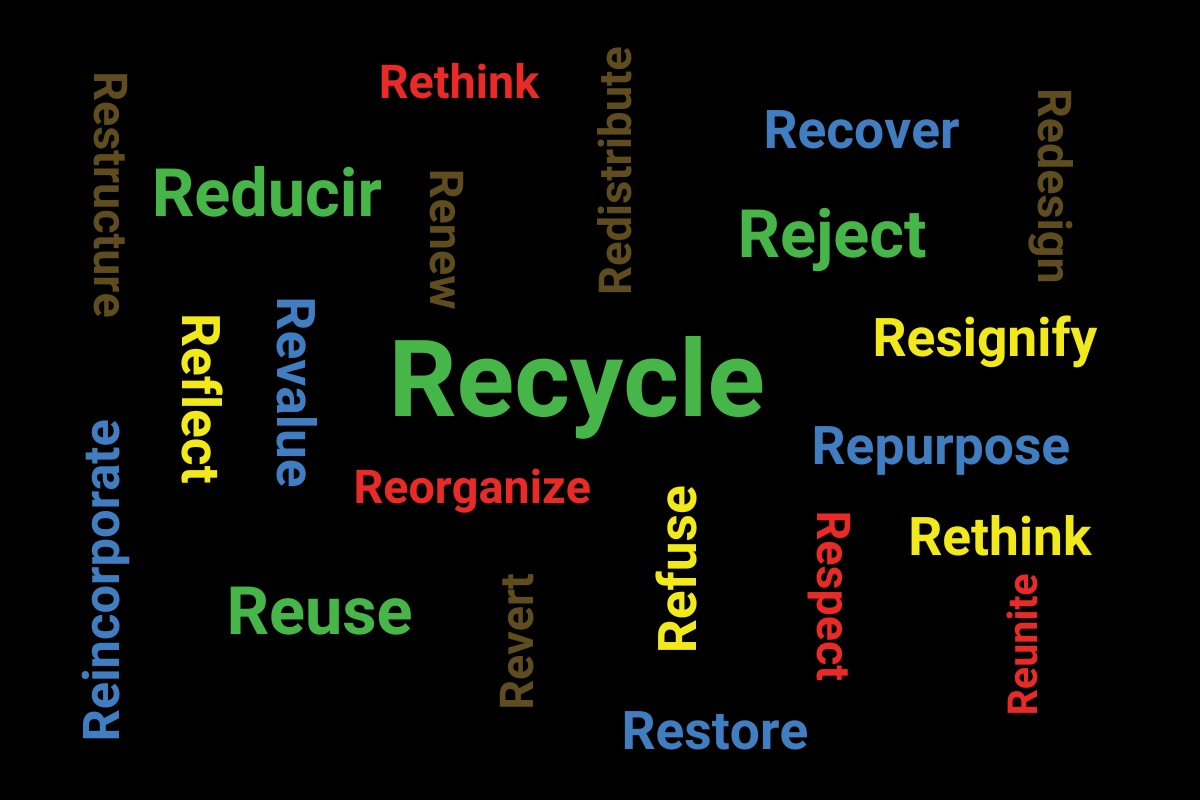How did it all start? For most, it started with an R: R for recycling.
Before long, that first R was joined by two more that seemed very important: Reduce and Reuse. And these two new Rs had to take place before the first one. That is, the best thing was to first reduce consumption, then reuse what you already have, and finally recycle instead of throwing away as garbage.
Next came Reject. That R is for immediate action—for example, when you go shopping and you can say, “No bag, please!”
And when did it all start? In the month of April: on April 22, 1970, when the first Earth Day
took place in the United States.
Today, in a world increasingly aware of human impact on the environment and how that affects our planet and our survival, the amount of Rs continues to grow. Those who in 1970 were perhaps a minority, are today thousands or millions of people who see a planet in crisis. We want to know how, from our homes, we can be part of the change. But even today, it can be hard to know exactly how to proceed.
A Google search takes us to thousands of sites that talk about seven R, nine R, five Rs. In a recent conversation on the topic with our WhatsApp Entrepreneurs 506 community (are you an entrepreneur in Costa Rica? Join our community here), a Costa Rican entrepreneur, lover of sustainability and responsible companies, told us that there are places that quote up to 17 Rs.
So, what are some of those R?
Here are 22 R that we found online. They’re all words and concepts aimed at reducing the impact we have on the planet, particularly with our solid waste:
Reduce, Reuse, Recycle, Reject, Recover, Rethink, Restructure, Redistribute, Revalue, Resignify, Redesign, Rethink, Renew, Restore, Recondition, Reunite, Reflect, Rethink, Reincorporate, Respect, Reorganize, Resign, Reverse…
Some of those Rs might be redundant, and maybe that’s why the list keeps growing.
Why? Because our situation is complicated—so the advice and terms and methodologies we’re using to reduce our impact are increasingly more complex, more global. And by integrating them, we come to imagine and see more efficient production processes, as proposed by the circular economy.
But you know what? Many people, including me, still don’t know which container we should throw in the trash, and which one to send to recycling. So at El Colectivo 506, we decided to go back to the beginning and dedicate this edition to that first R.

Why dedicate a whole edition to recycling?
At El Colectivo 506, we believe that this action—analyzing, choosing, cleaning, drying, and separating our waste between what is garbage and what is recyclable—is the clearest and most direct way to understand how much waste we generate in our homes, offices, and communities. And when we have that clear picture, we can then do so much more. We can Rethink the way we consume, the way we value (or Re-value) objects, the way we distribute (or Re-distribute) our resources. That way, we can achieve less and less solid waste that ends up in the trash.
We also decided to dedicate an entire edition to recycling because it is the last link in the chain of the circular economy. It’s an effort that ensure that everything we consume and produce has a smaller impact on our planet.
What is the circular economy? As the image created by the European Parliament shows, it is a production and consumption model that seeks to reduce the extraction of raw materials and energy, maximizing the use of what is produced. How? By changing the way we produce and consume—from design, right down to the way we dispose of the product.
Costa Rica’s National Circular Economy Strategy from 2023 explains that:
“The circular economy as a sustainable production and consumption model has proven to be a cost-effective mechanism to decouple economic growth from negative socio-environmental impacts, such as GHG [greenhouse gas] emissions and waste generation, among others. The adoption of this model demands the creation of new economic activities with greater added value and better paid jobs due to the degree of technology required throughout the entire production chain that goes from the collection and recovery of parts, to the reincorporation of materials. to new economic cycles without generating waste.”
So recycling will never go out of style. That’s why it must become part of our daily lives.

What will you find in our edition ‘Recycling closes the circle’?
As Costa Rica’s first national media outlet for solutions journalism, we are going to present some of the solutions that are being applied in our country to increase the collection and processing of recyclable and revaluable materials—in the private sector and in the public sector, and in various regions.
We kicked things off by asking for your feedback through our National Survey on Recycling, which we shared online. By the time the survey closed on Tuesday, March 5, 247 people had taken 10 minutes out of their day to tell us about their experience with recycling. That means that Costa Rica dedicated 2,470 hours to start this conversation with us.
The path continues today with this first installment of our edition. Throughout the month, we’ll be bringing together the voices of those 247 people; of those who are applying responses to the problem of solid waste management in the country through recycling; and of our sponsors, companies committed to Costa Rica and the environment.
Welcome to “Recycling closes the circle.” Thank you for being here.





